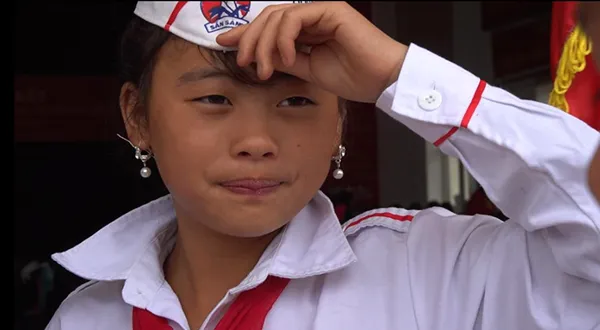 |
| Di in New Directors/New Films highlight Children Of The Mist, directed by Diễm Hà Lệ (Ha Le Diem) |
The mist rises fast in the northern mountain region of Vietnam where the indigenous Hmong community resides. Just as fast as girls have to grow up, because of an ancient marriage custom that takes place around the time of the Lunar New Year.
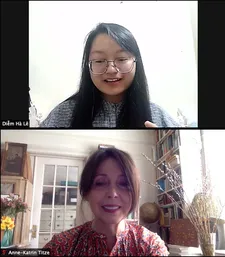 |
| Diễm Hà Lệ with Anne-Katrin Titze: “My Hmong friends started to introduce me to their culture and I was very curious about this.” |
Diễm Hà Lệ’s breathtaking documentary Children Of The Mist - (a New Directors/New Films highlight and Best Directing award winner in the International Competition at IDFA 2021) tells the story of Di, who lives with her family in a remote village, surrounded by pigs and puppies and kittens and chickens who all live together in a big barn-like structure, complete with an open fire and cordoned off sleeping areas.
The mother makes indigo to dye fabric, they tend to the rice paddies with their neighbours, herd the buffalo, and when Di isn’t at school or working the hilly fields with her family, she plays with her girlfriends the way most 12-year-olds do all over the world. But the game of “kidnapping-the-bride,” we soon find out, is much more serious than make-believe. Harmless actions taken in jest can have dire consequences.
Filmed over three years of her protagonist growing up, Diễm Hà Lệ’s Children Of The Mist gives us an intimate glimpse into customs that feel alien and familiar at the same time.
From Vietnam, Diễm Hà Lệ joined me on Zoom for an in-depth conversation on the film.
Anne-Katrin Titze: You made a beautiful film! How much did you know about the Hmong people before you started filming? How did it all begin?
Diễm Hà Lệ: My Hmong friends started to introduce me to their culture and I was very curious about this. In 2016 I decided to take a bus to the North of Vietnam. I went alone and it’s really hard because Hmong people live very separated from the rest of Vietnamese people. They live on the highest mountain in Vietnam. The first time I went to one Hmong village, they can understand Vietnamese and speak Vietnamese but they pretend to not understand Vietnamese.
AKT: Okay!
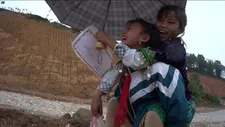 |
| Di laughing with her friend |
DHL: Yes, it’s really weird. And I didn’t do anything with them and I got to Hanoi and six months later we decided to open a little workshop for Hmong children in Northern Vietnam. And my Hmong friend went to Northern Vietnam and we stayed in Di’s house, my protagonist’s house, because her dad had a very open mind. He wanted us to open a workshop for Hmong children and that’s why we had access to stay in my protagonist’s house.
AKT: So it was the father who invited you to stay?
DHL: Yeah, it was the father. And after that my friend went back to Hanoi and I continued to stay in my protagonist’s house. I went to their house five to six times one year. Each time I filmed for about three or four days and I spent the whole time living together with them.
I went to the rice fields with them and took care of the buffalo and hung out with Di and her friends and went to the village. Di’s parents took me to a wedding and every social event, even to drinking alcohol with them.
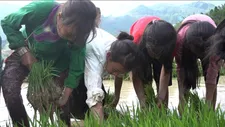 |
| Girls working in the rice paddies |
AKT: It becomes clear that you are so involved in the family life. I have never heard in any documentary someone say “Don’t cry!” To the filmmaker! At another point, you are being asked “Do you hate me, Diễm?” And you respond with “Yes I do, because you fell into a terrible trap!” I loved that it was so obvious that you were making the film and had become a part of what is going on.
DHL: At first I wanted to use my camera just for standing and watching them and just filming. Then they started to ask me about my opinions about their life and about their choices and I felt like a filmmaker but on the other hand a human too. I have my feelings, so I decided to talk with them also about my feelings.
AKT: It’s great and not the fly on the wall at all because you are very much involved and don’t hide it. Early on, you show us the girls playing “kidnapping of the bride.” How the girls are giggling and squealing and running around and playing, that could be anywhere in the world. That kind of behaviour is a memory of my childhood - it is completely universal what you capture about childhood, about girls playing together.
DHL: Thank you! That was the feeling when I was filming this. It reminded me of my own childhood because my friend got married very young and that’s why I wanted to have it in this film.
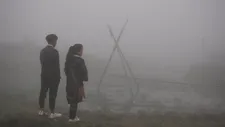 |
| Di with Vang in the mist |
AKT: It’s playacting that turns very very serious. At first you may think that they just make up a story of kidnapping, when you are not informed about the customs. Then slowly the reality of it dawns on us. Were you yourself astonished about the fine line that they are treading? On the one hand they have phones and are on Facebook, on the other their life is ruled by very old traditions, that include girls being sold in a way.
DHL: That was my feeling when I started filming this film. At the beginning everything seemed very innocent and happy. One year later, I realised what bride kidnapping is in their culture, because at first I thought it’s just like a story.
AKT: A made-up tale, yes.
DHL: But it happened while I was filming. It happened to one of Di’s classmates in her school. A girl was kidnapped and sold to the Chinese border. It was also freaking me out. I was really afraid that one day Di, my protagonist, would disappear.
AKT: Can you fine-tune the age for me? How old is Di at the beginning and how old is she at the end of filming?
 |
| New Directors/New Films screens at Film at Lincoln Center Photo: Anne-Katrin Titze |
DHL: In the beginning of the film she was 12, in the end she was 16.
AKT: When the story with Vang happens, how old was she then?
DHL: When the kidnapping happened she was 14 and a half.
AKT: Where is Di now? What is going on with her at the moment?
DHL: It’s a long story.
AKT: Please tell a short version. I feel very much involved after seeing your film. You make us care for her.
DHL: She sent me the picture of her little daughter. She now is 18 years old and already has a little daughter. After the kidnapping she convinced her parents to let her go to high school. It’s a boarding school 20 km away from her village.
She tried very hard and she got a scholarship for three years. We were very proud about that, because this scholarship allowed her to attend any university in Vietnam if she finished high school. But one year ago she fell in love and she moved to another man’s house and she got married and now she has a little daughter.
AKT: It’s not the kidnapping guy, though?
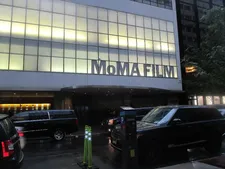 |
| New Directors/New Films screens at the Museum of Modern Art Photo: Anne-Katrin Titze |
DHL: No, not the same guy. But she didn’t finish high school.
AKT: The school that we see in the film is very important. It’s much more than a mere school in this environment. It’s like a safe haven for the pupils. I loved the moment when you show the teacher telling them that helping grandma with the harvest is no excuse, you cannot herd the buffalo right now, that has to wait until after school. The discrepancy is very well shown.
DHL: It was also my experience. I’m also from another ethnic group in another part of Vietnam. In my experience, school, in my opinion, it’s the only way to have a chance to discover the world. That’s why I stand by the schools’ way. But sometimes Hmong parents don’t believe in school.
Often for many Hmong children the school is very far from the village and girls are kidnapped and sold to the Chinese border and sometimes the parents don’t have anyone to help them with the rice fields and they prefer their children to work in the rice field. It happened with my protagonist and other Hmong children in the class.
AKT: The environment where they live is so interesting to see. The layout of the house, the architecture and how they live with the animals. Little pigs and puppies, kittens and chickens and all of them running around together. Is this a very traditional Hmong house?
DHL: Yes it’s very traditional for a Hmong house and I enjoyed living in my protagonists’ house very much with all the animals, too.
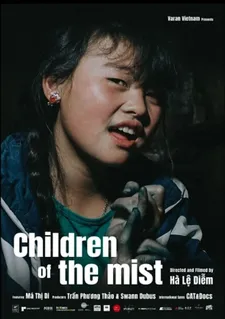 |
| Children Of The Mist poster |
AKT: The mother is an interesting woman who has a tricky sense of humour. She says “when I’m drunk, who is going to feed the pigs?” and we think she is joking, but no, she repeats it later on and is quite serious. How are they doing, the parents? Did they see the film?
DHL: They haven’t had a chance to watch the film because of the Covid situation in Vietnam. Maybe I’ll go in June to their village to show the film. Maybe Di’s daughter is grown up and I can meet her.
AKT: I’m teaching here in New York at Hunter College about fairy tales and storytelling and I have students from all over the globe. There are so many tales about women given away, century-old rituals and traditions. I am going to recommend your film to my students.
DHL: Oh thank you!
AKT: It’s so relevant. If you think about it. Still in 2017 you could get married with parental consent at age 14 in New York State. It’s actually not far away, but very close to a surprising amount of places. Are you coming to New York for New Directors/New Films?
DHL: I’m sorry but I won’t be able to come to New York.
AKT: Sorry to hear that, but I’m so glad to have talked to you about your great film!
DHL: Thank you so much!
The New Directors/New Films screenings for Diễm Hà Lệ’s Children Of The Mist will take place on Saturday, April 30 at 3:15pm, Film at Lincoln Center’s Walter Reade Theater; Sunday, May 1 at 12:00pm, Museum of Modern Art’s Roy and Niuta Titus Theater 2.
Film at Lincoln Center and the Museum of Modern Art present the 51st edition of New Directors/New Films from April 20 through May 1.





















